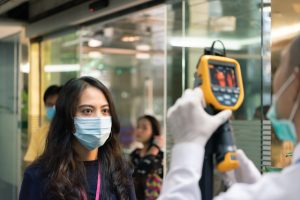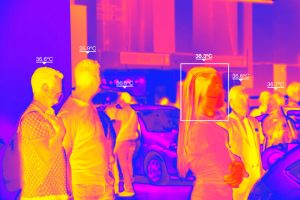Thermal imaging solutions are widely used for human body temperature measurement and fever screening at busy retail spaces, office buildings, travel hubs and other venues. While most people see thermal cameras as a solution for “here and now” in the light of the current Coronavirus outbreak, investing in such solutions, in fact, helps them to future-proof their businesses. A thermal imaging solution minimises contagion by identifying people with high fever, but also boosts the confidence of fellow workers, shoppers and travelers that detection is in place.
Fever Scanning for now and the future that doesn’t cost the earth
In early 2020, Covid-19 became a world-wide pandemic and forced organisations to change the way they do business. The current situation already seems to be getting under control, but pandemics remain a major concern for the World Health Organisation (WHO), governments and the general public as the next flu season is only a few months away. With this in mind – having a thermal imaging solution in place is a must at present, but also a necessity for the future.
The need for smart thermal imaging solutions now and in the future is evident in so many environments: factories, warehouses, banks, museums, public transport, hospitality organisations, offices, shops, hospitals, call centres, event venues and more. Here is all they need to know when it comes to thermal imaging systems that start at around £900.
The basics
Any object with a temperature above absolute zero (-273.15 ° C) is constantly emitting infrared radiation (thermal radiation). A thermal imaging camera calculates the corresponding temperature information according to this radiation and presents it as a heat image on a screen. A thermal camera can quickly screen subjects for elevated body temperature in enclosed spaces (indoors). The best and most effective method of installation is always to have someone monitoring the thermal imaging system. However, if this is not possible, cameras with screening mode can be set to alarm when detecting an elevated temperature.
Fast forward
This guide describes the various ranges of thermal imaging solutions as well as the factors to consider when choosing among them. It then focuses on two solutions provided by ITSL Group. At the end of the guide, you will find an easy-to-follow checklist for choosing the best fitting solution.
The typical ranges of thermal solutions
When using a standard thermometer, the temperature readings are at a single point. A thermal camera uses thousands of temperature readings to build up a 2D image of a person’s face. This results in improved screening and more accurate temperature measurements. While thermal imaging is advantageous over other methods, there are significant differences in the ranges of thermal solutions available on the market. The following paragraphs discuss these in more detail.
Entry-level thermal detection
In this case, the thermal camera (scanner) is a single standalone unit. It is either handheld or mounted on a tripod. It is used to measure the temperature of one person at a time. Normally, the scanner is not connected to a database which limits image recording and data analysis at a later point. Many solutions in this range come with connectivity to an external display for monitoring of both optical and thermal images. The general advice for this range of thermal solution is to avoid physical contact with subjects to minimise cross-infection. Another point to consider is the speed at which people pass the environment – at busy hubs, the use of a handheld scanner will be very inefficient and may cause crowding, which is, of course, something the world is working to avoid at the moment.

Mid-range thermal detection
Medium range thermal imaging solutions allow people to be monitored in volume and can be upgraded with facial recognition technology if required further along. Thermal cameras in the mid-range introduce secure social distancing i.e. the operator and the target persons are at a safe distance. This range comes with a dedicated PC, a monitor and simple to use software. With fast response times and the capacity to measure multiple people at once, there is no need to slow down the traffic in the detection area. Mid-range thermal cameras are multifunctional and I.P-based, meaning that these can be used in wider applications, other than temperature measurement.
High-end thermal detection
The professional range of thermal imaging solutions has many similarities with the mid-range solutions – it allows for contactless temperature detection of many people at the same time. The main difference is that the high-end range comes with a dedicated central management system and can seamlessly integrate data from multiple checkpoints, it could have a database of named people with all their previous readings and has many more uses than just temperature screening. A high-end thermal detection system is an enterprise grade solution capable of full networking and network management. The speed and accuracy of a professional solution are higher than the other types of thermal detection systems.
Factors to consider when choosing a thermal imaging solution
After the high-level overview of each range of thermal imaging solutions, this section focuses on the specific factors and technical requirements that the buyer should consider in his decision-making.
Measurement accuracy
Most thermal imaging solutions have an accuracy of ±0.5°C. Cameras with accuracy higher than ±0.5°C require real-time calibration with a “BlackBody” and intelligent compensation. The accuracy of a “BlackBody” calibrator is currently ±0.1°C, resulting in a camera measurement accuracy of ±0.3°C. This is not a given for entry-level solutions. The “BlackBody” calibrator can be purchased as an extra to a mid-range solution, whereas a high-end thermal detection system comes with it by default. In short, when deciding on measurement accuracy, the typical range of error is between ±0.5°C and ±0.3°C.
Traffic
A major consideration when choosing a thermal imaging solution is the amount of traffic at the venue or hub where the solution will be installed. As already indicated, entry-level solutions scan one person at a time. This means that such a solution is only appropriate for a low-volume traffic environment where the delay in temperature measurement will not cause crowding. Mid-range and high-end solutions can scan up to 30 people at a time. The main difference between the two is that the professional thermal camera would scan 16+ people within 30 milliseconds. The response of the mid-range version is within 1 second. This does not sound as much of a difference, but depending on the flow and volume of people, the professional solution will make a big difference in the confidence level of readings.
Detection range
Detection range is the distance at which a thermal camera can scan a person’s temperature. Entry-level and handheld solutions detect temperature at a distance of 1 metre. Mid-range cameras can scan people between 1 metre to 3 metres away. High-end solutions detect a person’s temperature from as much as 5 to 10 metres away. Detection range is an important consideration to take into account when choosing a thermal imaging solution.
Thermal resolution
A higher resolution is important in thermal imaging because more data points mean more information is provided for accurate thermal interpretation. More pixels also mean greater visual resolution in the thermal image. Most thermal imaging solutions come with a standard thermal resolution of 160×120. High-end solutions have higher resolution, but this does not make lower-range thermal cameras inferior. The resolution of an output image from a mid-range thermal camera can be higher, thus providing a sufficient level of detail.
Automatic alarms
The very basic entry-level solutions do not offer a sound/light alarm capability when elevated body temperature is detected. Other configurations have this option at a basic level. Mid-range and high-end solutions have the alarm feature by default.
Additional capabilities
High-end thermal solutions come with advanced features such as facial recognition and health archive access. Thermal cameras can be used for applications other than temperature screening. Examples include CCTV surveillance, license plate recognition and attendance monitoring. Depending on the buyer’s requirements, such additional features eliminate the need of having multiple screening systems but rather focus all capabilities in one solution.
With these requirements in mind, in the following two sections ITSL Group presents two thermal imaging solutions – the mid-range UCAM system and the high-end BTC solution.

Focus on a mid-range thermal imaging solution: UCAM
UCAM provides the ability for a group of people to be monitored simultaneously. The temperature measurement accuracy is within ±0.5°C if the camera is not calibrated. The solution, however, allows for precise calibration with the installation of a “BlackBody” calibrator resulting in an accuracy of ±0.3°C. The calibrator is not part of the core package and can be purchased as an extra.
The mid-range thermal camera is suitable for fast-moving crowds and busy environments. UCAM can scan up to 7,200 people per hour at two people passing it per second. The camera can optimally measure body temperature between 1 and 3 metres away. The thermal imaging resolution is the standard 160×120 with an output image resolution of 320×240.
UCAM comes with a dedicated PC, monitor and simple to use software. The software can show a side by side view of all information captured within the highlighted box. This gives a very easy to read visual representation of anybody heat-recorded with either a visual or voice alarm activated when a discrepancy has been identified. Alarms are triggered to feedback information if someone is showing a fever.
The UCAM thermal imaging system has a few additional capabilities. Facial recognition is one of them. This relates to attendance monitoring – known persons can be tracked when entering and exiting a building. The software can run a report and highlight if a person is missing or still on the premises. If you require your visitors to wear a mask, the facial recognition engine can be configured to detect if an individual is wearing one and play out a message asking them to put one on if they are not.
When it comes to pricing, this solution is more affordable but without compromising on quality and results. Talk to ITSL today for a tailored installation quotation and available options.
Focus on a high-end thermal imaging solution: BTC
BTC thermal imaging is by far the best type of system for monitoring large groups of individuals. It is accurate within ±0.3°C as it comes complete with the “BlackBody” calibrator and full software package. The BTC unit has enterprise-grade software as opposed to a simpler level of software on the mid-range UCAM solution.
Each camera can successfully scan 16+ people simultaneously with 30 millisecond response times between frames. The system will scan up to 18,000 people per hour. This means that a vast number of people can be thermally imaged in seconds, giving user feedback on potential health issues within a crowd. The database can constantly update itself with known parties’ “usual” body temperatures for more accurate monitoring over time.
The thermal camera has a detection range of 2.5-10 metres meaning that more people can be scanned at a time. The BTC thermal camera has a better thermal resolution – 704×576, thus allowing for even more accurate measurements. Automated alarms are a standard capability of this type of thermal imaging system.
While the mid-range UCAM solution can connect 4 cameras back to one PC, the professional BTC system is an enterprise-grade solution capable of full networking and network management with no upper limit.
How about additional features and capabilities? Facial recognition is included as well as database storage of known/named people and all their temperature records. The system can be used much like a standard CCTV – for surveillance and premises monitoring. Full video recording is available for future reference. License plate recognition is part of the CCTV section of the software. Much like the UCAM solution, BTC allows for attendance monitoring. A useful extra of the BTC system is the mobile client which can be used to remotely access real-time video and recordings, receive device alarms and control devices.
Talk to ITSL today for an installed solution quotation plus available options.
A checklist to choosing a thermal imaging solution
Requirement |
|
Do you need more than one thermal camera for temperature screening? | Yes/No |
Do you expect to be screening more than 7,200 people per hour? | Yes/No |
Do you need longer than 3 meters detection range? | Yes/No |
Do you require thermal resolution higher than 160×120? | Yes/No |
Do you need a CCTV surveillance capability? | Yes/No |
Do you want to record video for future reference? | Yes/No |
If you have answered with a “Yes” to two and more questions, you are better off investing in a high-end thermal imaging solution. In any case, it is best to consult with ITSL’s experts as to whether the UCAM or the BTC system is more fitting to your needs. Start the discussion by writing to ITSL here!

